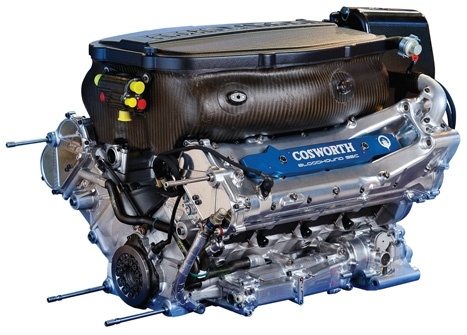Ian Bamsey, editor of Race Engine Technology magazine, recently reported in astonishing detail on the first Formula One engine to reach 20,000rpm on track. Here, we present before you all that Ian has reported about the Cosworth motor.
From 1906 through to 2006, Grand Prix engine speeds rose ever higher, from less than 2000rpm to, ultimately, a mind-boggling 20,000rpm. Then the rule-maker abruptly halted the march of progress, with a 19,000rpm rev limit for 2007, subsequently reduced to the current stifling 18,000rpm – plus, to add insult to injury, a moratorium on development. While engine evolution is back in 2014, the emphasis henceforth will be on fuel efficiency, rather than outright, untrammelled performance. The glorious Century of Speed is over.
The first Formula One engine to attain 20,000rpm on track was the Cosworth CA of 2006, and it is generally agreed that no rival surpassed it as the benchmark before rev limiting was cruelly imposed. These days, the naturally-aspirated 2.4-litre V8 CA lives on, powering Marussia in its close fight against Renault-engined Caterham for the honour of top dog among the young teams in Formula One.
Remarkably, although the CA is still on active duty, Cosworth has given RET full access to the innermost secrets of Grand Prix racing’s all-time engine speed champion.
Operating speed and horsepower climbed steadily during much of the 3.0-litre V10 era, preceding the switch to V8s mandated for 2006. It is widely agreed that BMW reached 19,000rpm first, in 2002. However, engine mileage requirements were lengthened in 2004 and 2005, which had the effect of pegging the ongoing crankshaft speed rise. Representative of the top 2005 V10s was the Toyota, which ran to a maximum of 19,200rpm and produced an estimated 930bhp mid-season. All of the 2005 V10s exceeded 900bhp, but it is not thought that any exceeded 950bhp, with the possible exception of the Honda at the end of the season.
Cosworth’s 2005 V10 was the TJ, which had its red line at 19,000rpm. Indeed, it had taken a relatively long time for the Northampton virtuoso to rise above 18,000rpm with its V10s. Nevertheless, with the CA, it took the uncompromising approach of targeting 20,000rpm from the outset. This was the first time it had produced such a high-speed V8 – the previous fastest running of the type had been its XF IndyCar engine, which ran to 16,250rpm in qualifying back in 2002 (immediately before the switch to a Cosworth-supplied spec engine for the CART series).
By regulation, the CA retained the per-cylinder displacement of the existing 3.0-litre TJ V10, which had a 95mm bore. As Cosworth’s technical director Bruce Wood remarks: “To go faster you just have to keep making the bore bigger, the stroke shorter and sort out your valves…”
At 20,000rpm, the CA’s maximum piston acceleration was 10,616 g, while the load imparted on each crankpin by the associated piston and conrod reached a very substantial 5937kg at that unprecedented speed. To put that into perspective, an anti-ballistic missile attains a g-force of only 100 g, while 5937kg is approximately two and a half times the weight of a Rolls Royce Wraith!
Check out the latest issue of the Race Engine Technology magazine for an incisive report of the Cosworth CA.

